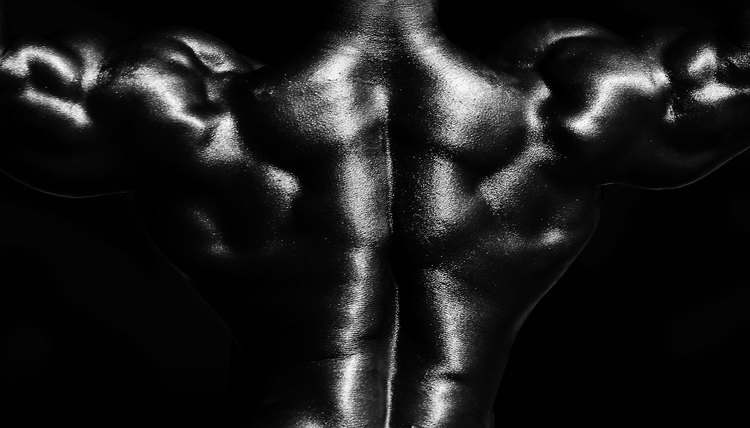Deadlifts for the Upper-Back Muscles

Deadlifts mainly work your hamstrings, glutes, core muscles, forearms and lower back and are usually thought of as a lower-body or full-body exercise. However, they also hit your upper-back muscles. Your trapezius and rhomboid muscles sit in the middle of your upper back and are responsible for drawing your shoulder blades together. To work these muscles harder when deadlifting, focus on pushing your chest forward and pulling your shoulders back at the top of the exercise.
Pulling from the Floor
The first phase of the deadlift is to lift the weight from a dead-stop on the floor. In the starting position, the bar should be directly over your feet with your shins lightly touching it. Adopt a shoulder-width grip and drop your hips down until your back is flat. Push your chest out and pull your shoulders back. In this position, your upper back is already working and you've not even lifted the weight yet. Keep your upper back tight and flat throughout the whole initial pull, advises trainer Stuart McRobert, author of "Brawn." Rounding your back increases your risk of injury.
Finishing the Deadlift
Maintain upper-back tightness throughout the pull and finish the lift by pushing your chest out and squeezing your shoulder blades together. In a powerlifting competition, the bar must be locked out fully for the lift to count. According to USA Powerlifting guidelines, failure to stand erect with your shoulders pulled back will result in disqualification. This final part of the deadlift is heavily reliant on your upper-back strength.
Deadlift Variations
While traditional deadlifts do work your upper-back muscles, most lifters won't struggle to pull their shoulders back to finish the lift if they've already got the bar above knee-height. For most people, the weak point in a deadlift is off the floor or just below the knee -- few lifters struggle because of a weak upper back. For a more upper back-focused deadlift, try rack pulls. Do these in the same way as regular deadlifts, but start with the bar elevated to around knee-height in a power rack or on lifting blocks. You'll be able to use more weight than pulling from the floor, and it will put more emphasis onto your rhomboids and trapezius muscles.
Building the Upper Back
Increasing your upper-back strength will undoubtedly boost the amount you can deadlift, notes Tony Gentilcore, strength coach at Cressey Performance in Massachusetts. Exercises like dumbbell rows, face pulls on a cable machine, chinups and lat pulldowns should all be staples in your program if you want to build your upper back and increase your deadlift performance. Do one upper back ancillary exercise for five sets of five repetitions after your deadlift session each week and devote another session entirely to variations of these exercises. Pick three or four lifts and do each for three sets of six to 10 reps.
References
- ACE Fitness: Barbell Deadlift
- Strength Training Anatomy: Frederic Delavier: April 2010
- Bodybuilding.com: The Deadlift
- USA Powerlifting: USA Powerlifting Technical Rules
- Tony Gentilcore: Stiffen Up Your Deadlift
Writer Bio
Mike Samuels started writing for his own fitness website and local publications in 2008. He graduated from Peter Symonds College in the UK with A Levels in law, business and sports science, and is a fully qualified personal trainer, sports massage therapist and corrective exercise specialist with accreditations from Premier Global International.
